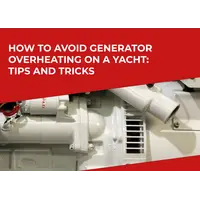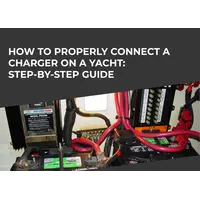In this article, topRik experts discuss using solar panels on yachts - one of the options for alternative energy sources, which is 100% environmentally friendly and silent. As usual, in our recommendations we rely on our own experience of sailing and powering both on coastal cruises and on long autonomous passages.
Based on this experience, we selected an assortment of solar panels, which are widely represented at our marketplace. In the section dedicated to these alternative power sources, you can now buy mono- and polycrystalline, rigid and flexible solar panels of the size and design you need. All products are from leaders in the production of marine solar systems: SunWare, Ultimatron France, Victron Energy, etc.
Determining the Energy Consumption of a Yacht
A significant increase in energy consumption on board yachts over the past decades has brought with it the need to modernize autonomous energy sources. Coastal and charter sailors do not depend much on this, since you can always start the generator to charge the batteries, because by the evening or at most the next day, the boat will be in an equipped marina, where both refueling and shore electrical power are always available.
It’s another matter when the transition is not planned for a couple of days, fuel supplies are limited and the prospects of plugging into an outlet in the evening are not so bright.
On average, very roughly, for a small boat of 10-12 meters the average daily consumption is about 150-200A. And this is with careful monitoring of non-critical consumers. But there are enough devices on a modern yacht that it is simply impossible to skimp on, at least for safety reasons, and not to satisfy the need for excessive comfort. For example, even a super-efficient LED anchor light bulb consumes 0.25 amperes per hour, that is, over 10 hours at night that is 2.5 amperes!
Hence the conclusion: every yacht owner should have a list of energy consumers on board in order to clearly understand which devices consume this energy from the batteries and which ones can be sacrificed if necessary.
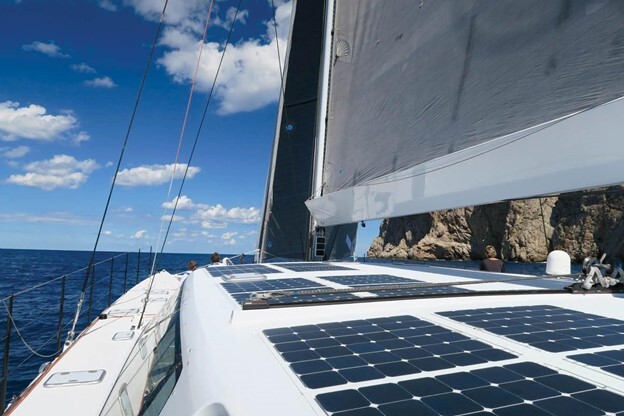
Equipment Inventory
Before installing any power generating equipment on a yacht, energy consumption is first considered. The consumption is calculated for both anchorage and sailing. The result is something like an energy budget that lists both the obvious big users such as refrigerators, displays, water heaters and lighting, as well as the less powerful devices - night navigation lights, pumps, gas alarms, engine monitors, entertainment systems.
An additional power reserve is provided for a thruster or electric winch. If a yacht has air conditioning, it is unlikely that renewable energy sources will meet its needs. In this case, it is better to think about a diesel generator or fuel cells.
Additionally, other generating capacities installed on board are taken into account: a wind generator, a hydroelectric generator and a DC-DC charger powered by a diesel engine generator.
Power Consumption Calculation
After the inventory list of electrical equipment has been compiled, next to each device, set its power in watts, and in the next column - the average time of use of this device per day, based on your own experience and the procedures established on your ship.
Multiplying the wattage by the average daily usage time will give you the daily energy consumption of each electrical device in watt-hours.
To calculate the solar panel power output required for your boat, you must first determine the total amount of energy needed to power all the electrical equipment on board, taking into account the power and time for which it will be running.
Your table should look something like this, just continue according to the electrical equipment on your yacht.
|
Equipment |
Voltage |
Voltage type |
W |
Ah |
Day |
Night |
||||||
|
|
On the move |
Anchored |
On the move |
Anchored |
||||||||
|
|
|
|
|
|
Hours |
Ah / day |
Hours |
Ah / day |
Hours |
Ah / day |
Hours |
Ah / day |
|
Saloon lighting 1x10w |
12 V |
Cont. |
10 |
0.3 |
|
|
|
|
8 |
2.4 |
|
|
|
Navigation lights 1x25w |
12 V |
Cont. |
25 |
2 |
|
|
|
|
8 |
16 |
|
|
|
Cabin lighting 4x10w |
12 V |
Cont. |
40 |
3.6 |
|
|
|
|
|
|
3 |
11 |
|
Anchor light 1x10w |
12 V |
Cont. |
10 |
1 |
|
|
|
|
|
|
8 |
8 |
|
TV |
12 V |
Cont. |
50 |
4 |
|
|
|
|
|
|
2 |
8 |
|
Devices (night) |
12 V |
Cont. |
10 |
1 |
|
|
|
|
8 |
8 |
|
|
|
Devices (day) |
12 V |
Cont. |
3.5 |
0.3 |
8 |
2.4 |
|
|
3 |
8 - 12 |
|
|
|
Radar |
12 V |
Cont. |
Up to 50 |
4 |
3 |
8 - 12 |
|
|
|
|
|
|
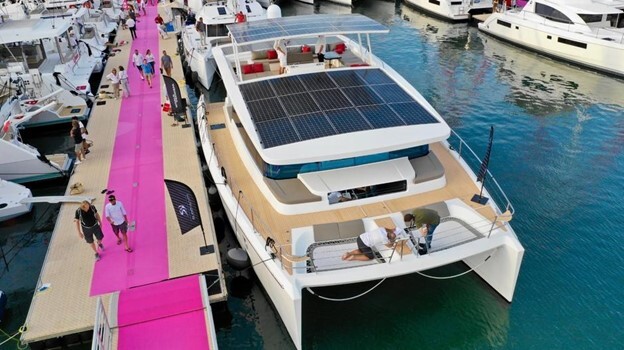
Once you have this information, calculate the minimum panel power output required to cover your needs. Divide the total watt-hours by the estimated number of daylight hours per day that the panel will capture sunlight.
Taking Into Account the Specifics of Energy Consumption
Of course, everything is not as simple as described above if you want to save as much as possible and at the same time take into account the specifics of energy consumption in autonomous navigation, provided that you use solar panels as a source of this energy.
Division Into Critical and Non-Critical Loads
For a more complete idea of how much demand this or that energy-intensive equipment is in long-distance (or coastal) voyages, divide all devices and instruments into two categories.
Critical devices are those without which a cruise or long-distance passage is impossible from the point of view of safety for the health and life of passengers: all navigation systems, radio communications, running lights, fresh water pump, refrigerator, freezer, etc. It is not advisable to save energy consumption when operating this equipment.
Non-critical equipment that consumes electricity and can be neglected on occasion because it will simply reduce the level of comfort includes all systems that are designed for entertainment. Under particularly difficult sailing conditions, lights in cabins, water heaters, a dishwasher, electrical cooking appliances, etc. can be transferred to this category.
Variations In Consumption Depending on Conditions
Be sure to take seasonal and weather conditions into account. Indeed, depending on them, the time you use electrical appliances, especially lighting, may increase or decrease, as well as the time and intensity of illumination of your panels by sunlight.
Determining Potential Energy Production from Solar Panels
It’s extremely helpful for course planning and efficient travel to calculate as precisely as possible how much energy from solar panels you can count on.
Solar Resource Study
The use of solar panels is especially important in areas with maximum daylight hours. Of primary importance when calculating hybrid energy systems using solar batteries is the actual insolation (irradiation of the surface with a parallel beam of light rays coming from the direction in which the center of the solar disk is visible at a given time). It can only be determined on the basis of constant observation.
High solar insolation is associated with a large number of sunny days. The insolation of a particular surface area depends on many factors: orientation, angle to the horizon, time of year, temperature, as well as the latitude of the area, which determines the zonality of solar energy distribution. This means that by clearly defining these criteria, the efficiency of using solar panels can be significantly increased.
You determine the number of sunny hours in the sailing region yourself if you visit it regularly. If this is a new region for sailing, you can use solar maps and special online calculators for preliminary calculations, and then make adjustments based on your experience.
Efficiency of Solar Panels
Above we described the three main types of solar cells: monocrystalline, polycrystalline and amorphous. Each of them has its own advantages and disadvantages. Thus, the conversion rate of solar energy into electrical energy for monocrystalline batteries can reach 23%. Until recently, manufacturers only offered rigid-wall models that accumulate solar energy from one rear wall. Double-sided models have now become available, allowing solar energy to be collected from both sides of the battery wall.
Polycrystalline solar cells, unlike monocrystalline ones, are still less efficient, especially in low light conditions. However, it is worth noting that the advantage will be low weight and lower cost. Therefore, it is advisable to install them on sea vessels that sail short distances, in areas with the maximum prevalence of sunny days.
Amorphous panels are the most economical option, although they are the least efficient of all the types of solar panels presented. Such solar cells are made of amorphous silicon, which, unlike other types of solar cells, requires diffused light to operate, i.e., it can be used in cloudy weather. Another advantage is the ability to use them in conditions of significant dustiness in the air. The advantage of such batteries is their flexibility, which allows them to be installed on a surface of almost any configuration.
In addition to the efficiency indicators of various types of solar panels, other factors that influence their performance should be taken into account: the inclination of the installed plate, possible shading from the mast and other structures of the yacht, the prevailing air and water temperature in the region.
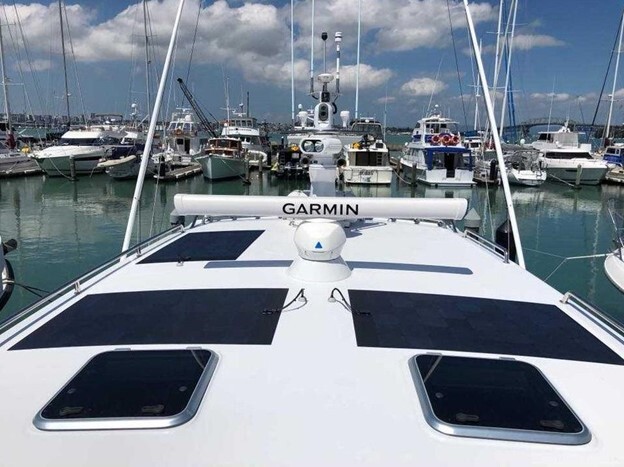
Calculation of the Required Area of Solar Panels
Taking into account the precise size of the panels, you can optimize the space on your yacht and avoid underutilizing the solar panels you are aiming for.
Selection of Solar Panel Utilization Factor
In the energy sector in general, and in solar in particular, the installed capacity utilization factor is used – ICUF. This is the average energy production per 1 square meter of the panel.
But if in traditional energy this coefficient is obtained due to the actions of people (one generator is working, the other is in reserve, the total ICUF is 50% in this case), then in solar energy it is determined by nature.
After all, solar panels do not work at night - even during the day and good weather, they work at half strength (on average), since the sun shines at different angles on the panel at different hours.
There are also cloudy days, precipitation, dust and different levels of atmosphere as the sun's angle above the horizon changes.
Due to these factors, ICUF is reduced by a factor of 4 and cannot be more than 25% anywhere on the planet.
It is generally accepted that the installed capacity utilization factor for solar panels is in the range of 10-25%: 10% is somewhere in the northern seas, 20-25% is somewhere in the tropics.
Calculation of Total Area
Now that you have collected all the information about the energy consumption on your yacht, studied the sailing conditions in the selected region and know the efficiency of the solar panels chosen for installation - it’s time to use this data to calculate the required total area of solar panels for your yacht.
The calculation formula is simple: you divide the total power required (in watt-hours) by the number of hours of sunshine in the region and multiply by the utilization factor.
As an example, let's use a 60 W solar panel on a small yacht, so as not to take up a lot of space for listing the equipment.

What can one such solar module provide? The average energy production of a product of this area does not exceed 400 Wh per day. But these data are correct provided that the solar panel is constantly oriented to the south and located at an angle of 60-90 degrees. As a rule, it is impossible to constantly comply with these conditions on a yacht, especially while in motion, so the power generated by the system will not exceed 200-300 Wh per day if the mounting structure is not rotatable. If you place the module vertically, and even build a rotating console for it, then the generated energy can exceed the average.
Even if we take into account the minimum energy generation data, such a solar module is quite enough to charge laptops, phones, tablets and navigation equipment without turning on the motor; LED lighting of the cabin and deck at night; briefly watching TV, etc.
What is needed for the correct operation of such a power supply system? You only need a solar module, a charge controller and a few meters of cable to connect the equipment with each other and with the battery. Also, to power devices with a voltage of 220 V, you will need an inverter or voltage converter 12/220 V, if one is not provided on the ship.
Even if you don’t have a small boat, but a large catamaran like Fountaine Pajot or Lagoon, the principle of calculating the total power and area of solar panels does not change, the list of electrical equipment that will be powered from these panels will simply increase significantly.
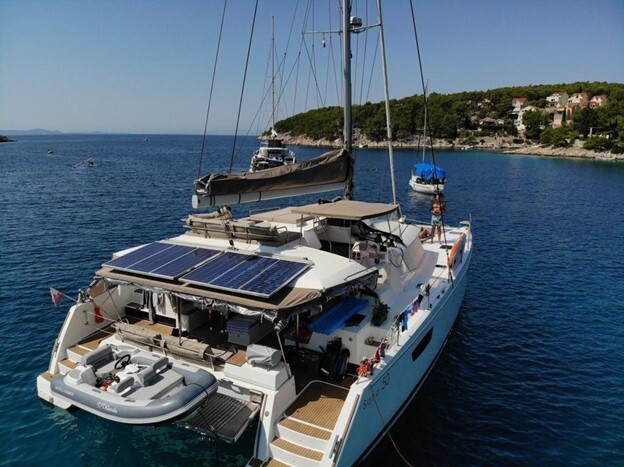
Selecting the Type and Configuration of Solar Panels
For use in marine environments, solar panels must meet special requirements for reliability and resistance to salt water, humidity and strong ultraviolet radiation. The panels are usually protected with special coatings that prevent corrosion and deterioration due to the marine environment. In addition, they must be resistant to strong gusts of wind and mechanical stress.
Solar systems for yachts also typically include components to maximize energy harvesting, such as sun trackers and control systems to optimize panel angles throughout the day. These systems help maximize the efficiency of the panels even as the sun's angle changes, which is critical in marine environments where changes in weather and direction of travel can significantly affect the amount of sunlight available.
Types of Solar Panels
The choice of solar panel type and specification for a particular yacht or vessel will depend on various factors, including the size and design of the vessel, planned routes and operating conditions.
The marine industry uses different types of solar panels, each with its own features, advantages and disadvantages.
Monocrystalline Solar Panels
They are made from a single silicon crystal, which provides them with high efficiency in converting sunlight into electricity. They work better in tight spaces as they provide more power from a smaller area. These panels have a long lifespan and a high degree of efficiency, but their cost is usually higher compared to other types.
Polycrystalline Solar Panels
Made of silicon, which contains many crystals. This makes them less efficient than monocrystalline panels, but they are cheaper and can be a good choice if the installation area is not limited and you can compensate for the low efficiency with more panels.
Innovations in solar technology have significantly transformed the energy use of yachts, making them more energy independent and environmentally friendly. Let's look at key aspects and examples of best practices for integrating solar panels into modern yacht design.
Flexible Solar Panels
Flexible solar panels represent one of the most significant innovations in this field. They can be installed on virtually any surface of the yacht, including roofs, biminis and even sails, which was previously not possible with traditional rigid panels. Flexible panels are made from lightweight, corrosion-resistant materials, making them ideal for marine environments. They not only improve the aerodynamics of the vessel, but are also able to withstand extreme sea conditions.
Embedded Photovoltaic Systems
Some luxury yacht manufacturers use integrated photovoltaic systems that can be built directly into the structure of the yacht, including the hull, roof and other parts of the vessel. These systems not only provide energy for all needs on board, but also help preserve living space and passenger comfort. Innovative technologies such as the use of composite materials allow these panels to be lightweight and highly efficient, increasing their ability to generate energy at a lower weight.
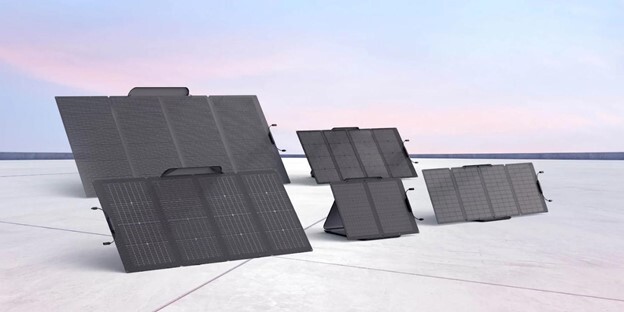
Location and Installation of Panels on the Yacht
The only real problem with using solar panels on a yacht is the available space to install them. Solar panels must be installed in an area that is continuously illuminated.
It must be borne in mind that depending on the location of installation of solar panels, their size and type are selected. Traditional monocrystalline and polycrystalline solar panels can be used if installed on a fixed rigid section of the yacht. If there is no space for standard modules, flexible modules can be used.
There are several main types of marine solar panels manufactured specifically for boats and yachts:
- stationary rigid glass panels with aluminum frame;
- portable solar panels;
- semi-flexible panels;
- flexible ultra-thin solar panels;
- highly flexible, rollable amorphous panels.
Rigid monocrystalline and polycrystalline panels have the lowest cost per watt of power generated, and the maximum power for a given area. However, these panels are the most expensive to install because they require rigid mounting to protect the panels from damage. Rigid panels operate at maximum power when mounted on brackets aft. However, in this case, the solar panels become vulnerable to waves and can be damaged when moored. Another good place is the top of the wheelhouse.
Semi-flexible polycrystalline panels are installed on the top of the cabin and other curved surfaces. Such solar panels are easier to install, do not require complex mounting hardware, and are much lighter than rigid ones. If the panels are made to order, they can be made to almost any size and placed where it is most convenient.
Amorphous silicon panels are placed on any surface, and if necessary, they are rolled up and put away for storage. In all cases, heating losses will be less if there is an air gap under the solar panel.
The solar panels themselves can be connected in parallel or in series. In the first case, the power is added up, in the second - the voltage, and we must remember that the panels must be close in characteristics. Each circuit has its pros and cons: with a parallel connection, the currents are higher and, accordingly, thicker wires are needed to compensate for losses in energy transmission.
Considering that solar panels are highly sensitive to even small voltage drops, it is necessary to use marine grade cable and terminals during installation. The contacts on the panel are vulnerable to corrosion and must be completely sealed. There should be no additional connections above the deck - one piece of cable is laid before sealing in the deck. If connections are unavoidable, they are made inside the boat.
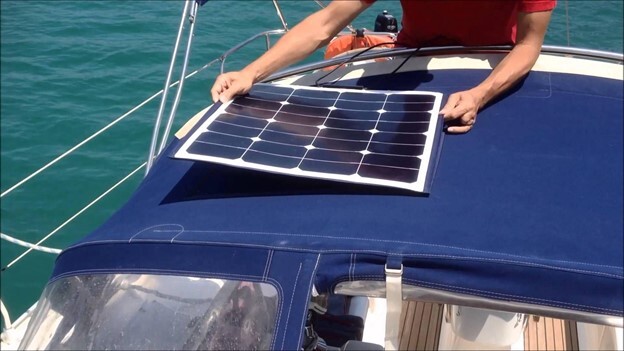
Consideration of Additional Factors and Accessories
By equipping a yacht with solar panels, you are essentially creating a small solar station. Therefore, you need devices for storing energy coming from the panels, current conversion devices and battery charge controllers.
Energy Storage Systems
Solar batteries play the role of an intermediary between the energy generator and the end consumer. They accumulate generated electricity, store its surplus and then provide it to the consumer. Batteries for solar panels allow you to:
- make the most of the energy generated by the solar power plant and optimize its operation;
- accumulate energy during the day and use it in the evening and at night;
- facilitate system operation during peak loads;
- increase the functionality of lighting devices and other energy consumers on cloudy days, with a lack of light exposure.
The controller regulates the charging process, and the inverter converts battery electricity in accordance with the parameters of the consuming equipment.
Based on the type of chemistry, batteries are divided into 2 large groups - lead-acid and lithium. Each group has several subgroups, whose representatives have their own characteristics and advantages.
Lead-acid batteries are available in serviced and maintenance-free types, with either liquid absorbed in glass fiber (AGM) or gel electrolyte (GEL).
In the group of lithium-ion batteries, those based on lithium iron phosphate (LiFePO4) and lithium titanate (LTO) are separately distinguished.
Alkaline batteries (Ni-Cd, NiMH) are not suitable for use in solar power systems, because they cannot accept a charge with low currents that solar panels produce. Small currents flow through alkaline batteries without increasing their capacity. Therefore, alkaline batteries are suitable for autonomous energy systems based on diesel generators, but not for solar panels.
Suitable for use in solar power plant systems:
- Lead-acid batteries of the AGM type, in the VRLA variation, are deep discharge devices equipped with thick plates and a valve to relieve gas pressure.
- Lead-acid batteries of the GEL type in the DC modification are deep discharge models with thickened electrode plates.
Lithium-ion batteries, especially models based on lithium iron phosphate. They are as safe as possible to use, charge very quickly, are capable of delivering up to 80% charge, are not afraid of deep discharge and incomplete charge, have a long cyclic life and high specific capacity. Compared to lead-acid batteries, Li-ion models of the same capacity are approximately 2 times lighter and more compact.
Charge Controllers
To charge batteries from solar panels, you need a regulator-controller that converts energy from the panels into charging current. There are two types of regulators:
- PWM (Pulse Width Modulation), which adjusts the charging current depending on the charge and condition of the battery and turns off when the batteries are fully charged;
- MPPT (Maximum Power Point Tracking), the principle of which is that the panels provide maximum power at a certain operating current and voltage.
By regulating the MPPT load, the controller extracts the maximum amount of energy from the panels under different lighting conditions. topRik experts' experience shows that MPPT provides up to 30% more energy than conventional regulators by making panels more efficient during morning and evening hours or on cloudy days.
The MPPT regulator allows you to output 10-30A or more depending on the regulator model and the number of solar panels and has a program for regulating the charging current, which changes in 3 stages. That is, MPPT can charge batteries most quickly and efficiently and keep them constantly charged without any intervention and completely free of charge.
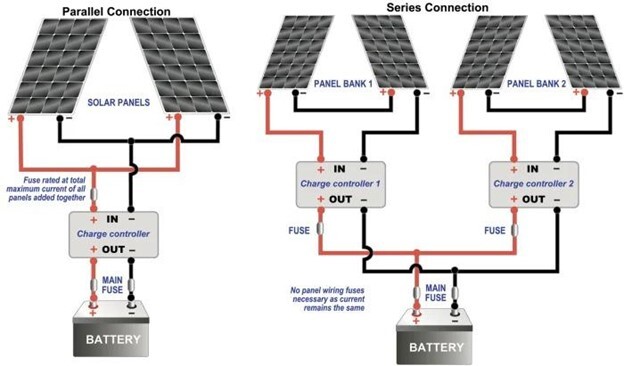
Inverters
A high-quality inverter for solar panels is a necessary element of any photovoltaic station. On yachts and catamarans, where alternating current is required for equipment operation, it is also impossible to do without this device, since the panels generate direct current.
Current converters, like solar panels, come in several types that differ from each other. The main distinguishing feature of an inverter that receives 12, 24 or 48 volts at the input and produces 220 or 380 volts at the output is the way it interacts with electrical networks.
For marine transport, two types of inverters are preferable.
- Autonomous option (inverters without a built-in charger) - designed for panels designed for completely independent operation, without connecting to an external network. The only task of these devices is to convert direct voltage from 12/24/48 Volt batteries into 220 Volt alternating voltage.
- Hybrid (combined) inverter - is a combination of an uninterruptible power supply and a solar charger, with the ability to manually or automatically switch between operating modes. These inverters combine two devices: an uninterruptible power supply and a solar charge controller. Such an inverter can work as an uninterruptible power supply, and the built-in charger charges the batteries from the network or generator.
Grid-connected inverters are suitable for domestic or industrial solar stations.
The inverter is connected between the solar panels that generate energy and all other elements of the circuit that consume it. During installation, two important rules must be observed. Do not disturb the correct polarity of connections with adjacent elements. In the event of an error, the entire network can suffer and even fail completely.
The length of the connecting cables must be limited as much as possible, and their cross-section must be selected according to the power (current). This will minimize losses and guarantee the safety of current transmission in the circuit.


